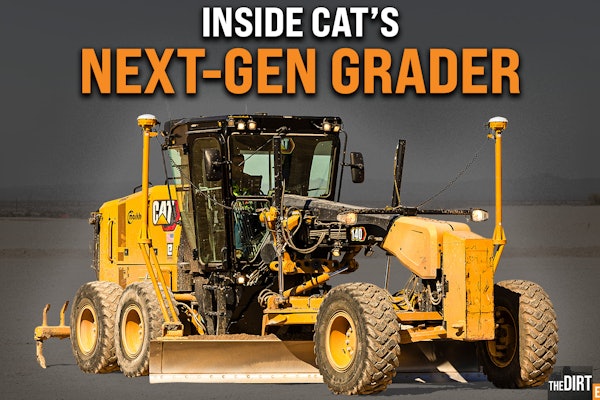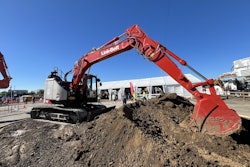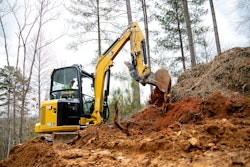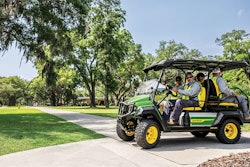Tired of the paper chase involved with tracking assets? RFID technology simplifies the process.
Although you may be unaware of it, radio frequency identification technology is almost everywhere, including electronic tags embedded in library books, inside cards needed to gain building access and in automated highway toll systems. Yet RFID’s most prominent, cost-saving solution continues to be asset tracking.
Using small, attachable electronic tags, RFID wirelessly tracks and identifies assets of your choosing. For contractors, this can include everything from hand tools to excavators as well as inventory, such as construction materials.
“Fixed reading devices (on site) or readers installed in PDAs or portable computers can wirelessly read the tags and automatically detect when an asset leaves a designated area,” says John Williams, marketing manager, CoreRFID. In addition, asset checks can be performed using a PDA to quickly identify specific items at a particular location.
Tag it, track it
Think of short-range RFID technology as a step up from using barcodes and long-range RFID (for anything over 15 feet) as two ways to distinguish assets. RFID has the capability to work well in hostile environments and when using long-range RFID and GPS together, it can provide an asset’s location and position. Users can also get digitally encrypted tag information to help preserve and prevent data tampering.
All RFID tags are not created equal, however. A tag used on a library book will not have the same characteristics as a tag created for tracking construction equipment or materials. Instead, tags can be built to suit their intended application.
“Tags used on heavy equipment must be more rugged, and depending on placement, they may need a stronger adhesive, or need to be water resistant and protected from elements,” says Erik Johnson, marketing manager, 3M Track and Trace Solutions.
Also be aware that some tags may not work well when attached to metal or in extremely dirty environments. In these cases it’s best to look for highly reliable tags with enclosed casings or those that can be securely riveted to the asset, rather than using an adhesive, according to Williams.
RFID tags have the ability to deliver either abundant continuous information or scheduled information. Active tags rely on an internal power supply, such as a battery, and can continuously stream data or offer two-way communication, while passive tags only transmit data when a reader is in its field.
The difference in tag function translates to significant cost differences: anywhere from $1-$4 per passive tag or $20-$50 per active tag. But again, the best solution depends on how often you want to monitor assets, jobsite conditions, optimum application range and the information you want to capture.
“With a long range (or active-based) RFID package, it’s easy to take a count of your equipment or consumables from long distances and in harsh environments, but hard to cheat the system,” says Ted Kostis, president, Silent Partner Technologies. “Unlike duplicating a barcode, you can’t duplicate the unique address of an active tag. Furthermore, you’re not just scanning it in or typing it in, the PDA or fixed reader has to ‘hear’ it.”
Once heard, Kostis says an owner sitting at the office can access data gathered by the in-field PDA through a SPT’s construction software and a web link to find out how often employees update the system and exactly what sits at every site. Another positive: If something goes missing, users can react immediately, versus trying to find items that may have disappeared long ago.
However, if you only want to log when someone checks out or returns a particular tool and not necessarily track it throughout the day, a passive system will work.
Some companies offer systems where an approved user can track items with a PDA in listen-only mode, instead of two-way communication mode. And for assets that don’t require long range RFID, ultra high frequency tags or barcode scanning can be employed.
“Passive systems help facilitate and trigger e-mails, where users can respond on a handheld device out in the field and determine which tools are missing and who was last issued the tool,” Johnson explains. While more cost effective than setting up wireless readers on site, it does take time to send someone out to the site to take stock of available equipment.
“Depending on the asset or application, a passive RFID system could be simpler and quicker to implement, but that’s not to say an active system might be suitable in certain cases. Selecting the tag based upon the unique conditions of the asset is the key,” Johnson says. 3M offers a wide range of passive RFID applications, and continues to explore applications in construction, mining, utilities and oil and gas.
For its Portable Data Collector system, CoreRFID relies on passive RFID technology because of its low cost and low maintenance – no batteries to replace – but says they are exploring active technologies for those in construction.
Light bulb moment
Just as RFID tag characteristics differ, so do tag uses – especially for construction applications. When RFID debuted in the construction industry, users relied on it to track and monitor large equipment fleets. Now, RFID companies say they have seen a shift to more materials tracking with increasing usage in the utility and site preparation sectors.
Case in point: Tampa Electric, based in Tampa, Florida, completed a pilot of SPT’s RFID-enabled system several Septembers ago in an attempt to solve its recurring problem of misplaced steel electrical wire reels.
“South Wire, the manufacturer who leases these reels to us, wanted them back within one year,” says Ron Petrus, operations manager, Tampa Electric. If they didn’t receive them in time, a $500 fee was incurred. But as the price of steel doubled and even tripled over the years, South Wire decided to raise its fee to $2,400.
Tampa Electric often misplaced at least 50 reels per year, either out in the field or at another facility, which added up to $120,000 spent in reconciliation fees. Not only that, the time it took to manually track the reels became too time consuming.
So Tampa Electric purchased 60 of SPT’s active RFID tags – about $25 to $30 dollars each – and invested around $15,000 in SPT’s construction software, for a total package price of around $16,800.
“For us, the return on investment was very good,” Petrus says. “We could get back what we paid for by not misplacing 10 reels.”
In the past, Tampa Electric enlisted a manual process to keep track of the reels: each had a unique number on it, which would be recorded and then kept on file until the wire had been used and the reel could be returned to South Wire.
Since contractors took the reels to various jobsites and didn’t have to install the wire right away, the reels often sat untouched for long periods of time. “We decided to flag the reels that had been sitting on jobsites for more than a year. When a reel came in, we place a tag with a unique serial number on it and also temporarily stored this information in SPT’s database,” Petrus explains.
Using a long range RFID-enabled PDA, an approved employee took inventory of what was in their facility and recorded the serial numbers. Tampa Electric then sent a Septemberly report to South Wire showing what they had in stock, in case any discrepancies came up. “With the system, if there was a problem we could reconcile as soon as possible,” Petrus says.
Tampa Electric also installed fixed RFID-readers at the main facility gate to document reels being taken out and when they returned. When a tagged reel was approximately 60 to 70 feet away, the reader would begin to acknowledge it and an administrator back in the office could see what was leaving the site. The company also tested the system by placing reels inside work trucks leaving for a job, and found it could identify them inside the trucks as well.
Petrus says this proved especially useful if a customer had a problem with service, allowing an employee to take a wire reel immediately and fill out the necessary paperwork later.
“Whenever a reel left the site, the reader would update the browser, showing a pull down count of inventory so users could monitor the outgoing reels,” Kostis says. If needed, users could take inventory every hour on the hour, without much effort.
What’s available?
All of these companies offer customizable RFID packages.
ToolWatch (www.toolwatch.com) allows customers to upgrade their TW5600 barcode scanner to a dual barcode/RFID scanning device with ToolWatch RFID, available this year. Upgrading helps users cut costs by having one scanning device, as opposed to two. The company also offers web-based construction software to aid in tracking assets.
CoreRFID (www.corerfid.com) provides not only passive tags but also the PDAs, readers, antennae and more. Customized tag services are also available, such as embedding tags in protective housings or providing them with clear visual identification.
SPT (www.silentpartnertech.com) offers both active and passive tags, barcode and UHF services, along with construction inventory tracking software, wireless readers and PDAs to capture data. SPT says its active RFID technology enables tracking up to 240 to 300 feet.
3M (www.3mtrackandtrace.com) plans to launch a more flexible, all-purpose version of its RFID technology in early 2010. The new global RFID asset tracking system will join the company’s existing RFID solutions. 3M manufactures complete tag, hardware, software and hosting solutions across multiple industry verticals and applications.
If you think your fleet may benefit from RFID asset tracking, contact an RFID provider to determine the best solution.









